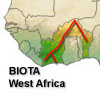Project description |
In southern and central Côte d’Ivoire, cultivation of cacao (Theobroma cacao) and concomitant perennial field crops (foremost coffee and banana) by local peasants is steadily increasing. It accounts for a drastic shift from subsistence farming to introduced cash crop farming. Cacao is the most important cash crop and it is largely grown by local peasants (who account for 80% of the producers).
This workpackage aims at revealing important reactions of various plant and animal taxa due to cacao growing. Based on the results obtained by BIOTA research in Côte d’Ivoire, the impact of cacao cultivation shall be studied along a gradient of land use intensity, with reference to the data obtained from the observatories in the Lamto Reserve protection area. The existing field plots in the Lamto region are supplemented by study sites in more intensely used areas in the vicinity of the Lamto Reserve (i.e. the close-by major cacao production area of Oumé). On all sampling sites, inventories of termite, ant, amphibian, and plant species are related to vegetation structure on the plots, to the vegetation mosaic in the surroundings, as well as land use intensity estimates obtained from peasants. Parameters for the development of an index of land use intensity will be identified, including groups of indicator species among the above mentioned taxa. Specific indicator values of certain species are to be detected by assigning them to defined land use practices. Some species may improve soil conditions (termites, ants) or be suited to be used as biological pest controls (ants, amphibians). They are to be recommended for sustainable management and special support.
|






 Go to the WeatherNet
Go to the WeatherNet BIOTA West Africa - Workpackage - CT2-T1-WP1a
BIOTA West Africa - Workpackage - CT2-T1-WP1a Impact of cash crop cultivation on biodiversity - Plant and animal diversity and cacao cultivation
Impact of cash crop cultivation on biodiversity - Plant and animal diversity and cacao cultivation